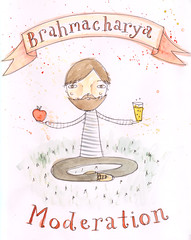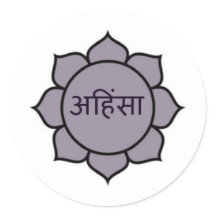This is the fifth and final article of a five part series based on this post: The Eight Limbs of Yoga (Part 1 – Yama)

The fifth of the five Yamas is Aparigraha, a Sanksrit word for greedlessness or non-grasping. It comes from the word parigraha, which means reaching out for something and claiming it for oneself; by adding the ‘A’ it becomes its antonym. Aparigraha, unlike Asteya, means taking what is truly necessary and no more.
Aparigraha instructs the students and practitioners of Patanjali’s “classical” Yoga (Raja Yoga) to consider what they really need, and to diligently question if greed might be driving them to pursue something simply to delight their senses once again. Patanjali says of Aparigraha: “When one is steadfast in non-possessiveness or non-grasping with the senses (Aparigraha), there arises knowledge of the why and wherefore of past and future incarnations.” (Yoga Sutras 2.39 – aparigraha sthairye janma kathanta sambodhah).
The reason yoga insists upon the practice of Aparigraha (non-greediness) is because every time something is pursued that appears on the “outside” of yourself, you get farther away from your own Divine essence which is inherently “within”. Take some time to ponder these words regarding Aparigraha by B.K.S. Iyengar in Light on Yoga: “By the observance of Aparigraha, the yogi makes his life as simple as possible and trains his mind not to feel the loss or the lack of anything. Then everything he really needs will come to him by itself at the proper time.”
While it is important for us have certain material objects in our life so that we can live without undue struggle, hoarding things and/or becoming obsessed with material possessions results in these possessions controlling the direction of our life. Seeing material objects simply as tools that can help us to accomplish our goals in life, can free us from being bound or controlled by these objects. When our focus is no longer directed outward towards the material world, we find we then have opportunity to focus on our inward spiritual journey that frees us up to create positive change and to purify ourselves. The student then recognizes that the collection or hoarding of things implies a lack of faith in Divine Providence to provide for their future.
Aparigraha also gives us permission to release any fear or clinging we may experience during loss of anything that we believe we “own”. This yama has a huge effect on both suffering and happiness whether momentary or in the long term. All suffering, no matter how intense, is caused by our resistance to loss (or change). It’s so simple, whenever we cling to something, we suffer; and this applies to both material things and concepts.
Implementing the practice of Aparigraha in your yoga routine can be as simple as deciding to let go of something during that session. For example; try letting go of the idea of doing an asana perfectly, or perhaps better than someone else. You can also let go of the fear of some difficult poses and approach them in a different way. When doing this, you’re letting go of your fear of change and loss, and you’re able to break free of habitual ways of thinking and/or doing.
Be mindful of what you are holding on to in your practice and consider what would happen if you simply gave that up. Do you unnecessary hold on to muscle tension? Are there places in your body where you can relax, yield and allow the energy to flow? Are you able to maintain a gentle attitude toward your poses, surrendering the impulse to try to achieve a goal that may be impractical or premature. Do you need to forcefully “own” a certain pose in your mind or can you surrender the notion of “owning” and simply visualize it and experience it through your body? This is a proper way to inquire according to Aparigraha.
 A quick summary: Aparigraha is really all about letting go. It’s about living the “now”, this present moment, and doing that with generosity, truth, and compassion; then its very essence can embrace all the other yamas.
A quick summary: Aparigraha is really all about letting go. It’s about living the “now”, this present moment, and doing that with generosity, truth, and compassion; then its very essence can embrace all the other yamas.
Stay tuned, the next series of articles will address each of the five Niyamas – See: The Eight Limbs of Yoga (Part 2 – Niyama)
 The forth of the five Yamas is Brahmacharya – a Sanskrit term that translates into English as “behavior that leads to Brahman”. The word brahmacharya stems literally from two root words – Brahma, (shortened from Brahman), represents the absolute, eternal, supreme God-head. (As opposed to “Brahmā”, the deity in the Hindu triad responsible for creation), and “Charya”, which means “to follow”. So Bramacharya is generally translated as activity, a mode of behavior or a “virtuous” way of life, i.e.; a lifestyle adopted to enable one to attain the ultimate reality.
The forth of the five Yamas is Brahmacharya – a Sanskrit term that translates into English as “behavior that leads to Brahman”. The word brahmacharya stems literally from two root words – Brahma, (shortened from Brahman), represents the absolute, eternal, supreme God-head. (As opposed to “Brahmā”, the deity in the Hindu triad responsible for creation), and “Charya”, which means “to follow”. So Bramacharya is generally translated as activity, a mode of behavior or a “virtuous” way of life, i.e.; a lifestyle adopted to enable one to attain the ultimate reality.





 Samadhi is a Sanskrit word which is the state of consciousness induced by complete meditation, derived from the verbal roots “samā” (the state of total equilibrium) and “dhi” (of a detached intellect).
Samadhi is a Sanskrit word which is the state of consciousness induced by complete meditation, derived from the verbal roots “samā” (the state of total equilibrium) and “dhi” (of a detached intellect).
 Dhyana is a Sanskrit word which means to meditate, derived from the verbal root dhyai, Dhyana it is the most common designation for both the meditative state of consciousness and the yogic techniques by which it is attained.
Dhyana is a Sanskrit word which means to meditate, derived from the verbal root dhyai, Dhyana it is the most common designation for both the meditative state of consciousness and the yogic techniques by which it is attained. Dharana is a Sanskrit word which means immovable concentration of the mind (or that which gives stability”) from the root Dhar, which means to “bind together”, “to make stable”. Dharanais the willful act of concentration of the mind.
Dharana is a Sanskrit word which means immovable concentration of the mind (or that which gives stability”) from the root Dhar, which means to “bind together”, “to make stable”. Dharanais the willful act of concentration of the mind.


 By controlling the act of breathing the student can efficiently and effectively control the various motions in the body and the different nerve currents that are animating the body. When practiced properly, one can easily and quickly gain control over body and mind through Pranayama, developing character and consciously harmonizing the individual’s life with the cosmic or Divine life.
By controlling the act of breathing the student can efficiently and effectively control the various motions in the body and the different nerve currents that are animating the body. When practiced properly, one can easily and quickly gain control over body and mind through Pranayama, developing character and consciously harmonizing the individual’s life with the cosmic or Divine life.